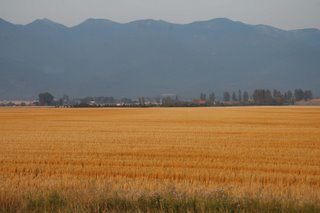5885 miles. 27 days – most of them solo.
Lost: One white t-shirt, one green SPF 45 hiking shirt, one camera lens cap.
Found: A new sense of the country we call home.
It’s been a long trip, but a worthy one.
For the moment, all I want is a few days OUT of a car. So Sunday, I fly home.
A full story detailing my adventures will appear in The Miami Herald’s print and online editions on Oct. 8. Meanwhile, with Stephanie’s help, we’ll be adding photos and video here. To see them, click on the Where’s Jane Today? icon on the top right; when you get the map screen, click on Videos/Photos at the bottom right.
I’ll be checking in daily to answer any questions you might have and to read your own comments and thoughts. Just click on the Comments button below.
For all of those who logged on with questions, encouragement and comments, thank you. You kept me going. Now it’s your turn to hit the road. Sign on and let the rest of us know how it goes.
Saturday, September 16, 2006
Home sweet home
Posted by
DARCOS CRUZ
at
9:48 PM
20
comments
![]()
![]()
Some fine days

A couple of fine, crisp days in Seattle took us to Pike Place Market, a seaplane flight (The Husband’s passion) with Kenmore Air and a ride on the ferry ($6.50 roundtrip) to Bainbridge Island.
Along the way, we stopped off at the Science Fiction Museum, next door to the Experience Music Project, both founded by Microsoft’s Paul Allen. (Both are well worth a visit, even if you’re not a Deadhead or a Trekkie.)
A few scenes: 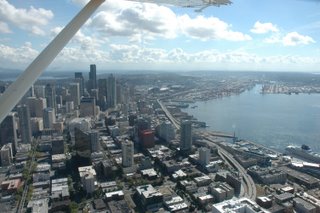
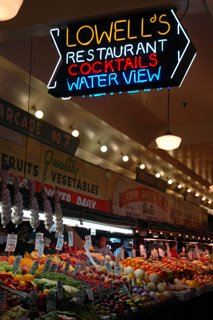

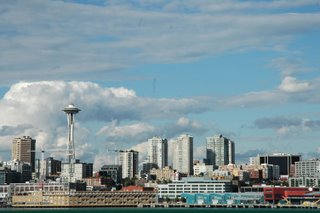
---
Photos:
Top, in downtown Seattle. Above: Seattle from the air, Pike Place Market, Seattle from the sea.
Posted by
DARCOS CRUZ
at
9:33 PM
1 comments
![]()
![]()
Family ties

Long-time readers sometimes ask about a story from years ago when my niece, then 18, and I retraced my own college backpacking trip through Europe. That niece, Kim, is still a travel fanatic. But she’s now 30 (!) and living here in Seattle, where she works for a tech start up.
Posted by
DARCOS CRUZ
at
9:29 PM
1 comments
![]()
![]()
Friday, September 15, 2006
Flying high

If you fly in the U.S., most of the planes you take were made by Boeing. Today you sent me to the Boeing factory tour, with a visit to its Future of Flight gallery.
You won’t learn any big secrets on this tour. The promotional films, factory visit and gallery are all clearly designed to obscure any details that might be useful to would-be terrorists and competitors. But you do come away with the sense that building airplanes is a complex business, involving a lot of people and computers, and that Boeing does it well.
The tour takes you to the factory where Boeing’s 747, 767, 777 and soon, its 787 planes, are put together. You never know who will be on your tour; our guide, Lynne Shrum, told us Microsoft chief Bill Gates turned up unannounced last week. His only question: How many employees does Boeing have in the state of Washington. Answer: 65,000 – more than Microsoft, which claims about 33,223, according to the Microsoft website.
The factory is a massive space, more than 110 feet tall, a half-mile wide and encompassing 472 million cubic feet. More than 24,000 workers toil here on three round-the-clock shifts. Some are assigned to bicycle duty; the factory is so huge that paperwork and small parts are delivered by couriers on bikes.
In the factoid department: More than 600 Boeing 777s have been built here, at a rate of 84 per year. Each requires about 5 months of factory assembly. The new 787s will use a far different process: parts will be manufactured in Italy, China and Japan, then shipped here for a final delivery process that takes only three days. Manufacture of the 787s begins later this year.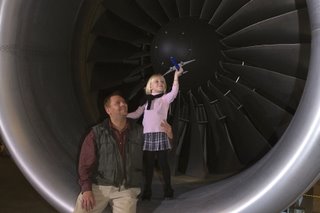
Back in the visitor center, you can buy Boeing gear: sweatshirts, pens, jackets, baseball hats – even toys. Boeing’s Future of Flight Gallery shows off engines, flight decks and more details about the new 787. Some 787 facts: These planes will be lighter (thanks to the use of composite materials), roomier, lighter and cheaper to operate. Each will have full Internet access onboard.
Whether we’ll all get more spacious seats, though, depends on each airline’s specific directions. I’m not counting on it.
Details: The tour lasts about one hour and costs $15 including the gallery visit. The factory is located about 30 minutes north of Seattle at Paine Field. Cameras aren’t allowed in the Boeing facility; photos here were supplied by Boeing.
Posted by
DARCOS CRUZ
at
5:43 PM
1 comments
![]()
![]()
Thursday, September 14, 2006
Let it snow!

When I left on this trip, nearly four weeks ago, the temps were measuring 90 degrees along much of my path. Today it snowed.
My assignment was Mount Rainier National Park. Unless you’ve been to the Pacific Northwest, you may not realize that the region is a giant rainforest. A temperate rainforest. And at the top of the active volcanoes of the Cascades, temperate can give way to something much colder.
“We get an average of 644 inches of snow each year,’’ said ranger Dan Phoenix. “Now we’ve got 642 to go.’’
Our last view of Mt. Rainier’s perfect cone was yesterday, as we were driving into the small town of Packwood just southwest of the park. Today, we got a mix of fog and rain and then, above 5,000 feet, snow.
Mt. Rainier is an active volcano, we learned. Currently it averages about 30 earthquakes a year – hundreds fewer than those experienced at Mount St. Helens before it blew in 1980. Rainier’s last big eruption came about 2,000 years ago. Theoretically speaking, Rainier could blow again at any time, and at some point in the future, it will.
Meanwhile, its glaciers are diminishing. The park boasts 25 now, versus 28 when the park was created in the late 1800s.
We weren’t able to see them; too much snow at the top. Still, it was a pretty visit. Said a fellow traveler from Pennsylvania, peering into Box Creek Canyon through the mist, “What are you going to do? We’re here now. We won’t be here next week.’’
Posted by
DARCOS CRUZ
at
9:49 PM
0
comments
![]()
![]()
Wednesday, September 13, 2006
By George, Washington
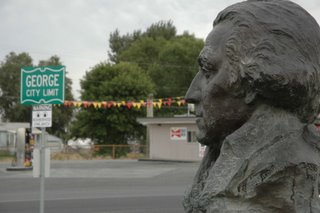
Whitefish, Mont., to Packwood, Wash., at the base of Mt. Ranier. 546 miles. A long day.
We took a break at George, Washington, just east of the Cascades. The name was irresistible.
The small visitor center was closed. This is a summer place, good for rodeos and agricultural celebrations. 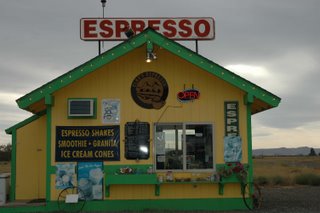
Even in summer, this town of about 500 is probably struggling. Two gas stations, two Mexican eateries, an espresso station, liquor store and Subway make up the bulk of the commercial establishments. Martha Inn, a family-style restaurant, is up for sale.
Still, you gotta love the name.
Posted by
DARCOS CRUZ
at
7:35 PM
0
comments
![]()
![]()
Tuesday, September 12, 2006
Florida connections
Florida seems like a long way from Montana, but Sunshine Staters are all around.
Dale Osteen, wrangler, told us he’d taken out several Florida groups this very week. On our Big Bus tour, we met a couple, Dennis and Susan Troseth, who live half the year in the Keys.
First night in Whitefish, we were graciously entertained by Jeff and Bridget Wirth of the local Sotheby's office, former Miamians we met through South Floridians Steve and Carole Smith, who have a house here. Jeff is working with Paul Milhous of Boca Raton on the Kootenai Lodge project near Bigfork here; also working on the project is the only other person I know in the area, Carol Beck-Edgar. Small world.
In the gift shop of the Glacier Park Lodge at East Glacier, we met Debbie Olson of Plantation. This is her second summer working in the lodge shop; her husband is driving a Red Bus tour. “It’s terrific,’’ she said.
And while stopped at a sporting goods shop, a couple approached. “You from Florida?’’ the husband asked, checking out the license plates. “Yup. Miami,’’ I said. “I'm so sorry. We’re from Tampa.’’
No escape.
Posted by
DARCOS CRUZ
at
1:56 PM
2
comments
![]()
![]()
Back in touch
Hi. After two days in Glacier National Park, I'm back in touch. The interlude was proof that there are still places in the U.S. without cell service and Web access.
Counterpoint: You can get a cappucino just about anywhere, even in the smallest crossroads.
Posted by
DARCOS CRUZ
at
1:55 PM
1 comments
![]()
![]()
A long walk on 9/11

The sound of rushing water cuts through the crisp morning air, the cascade just visible through the spruce trees and across the wide reach of a high Rockies valley. A stern rock rampart looms ahead.
“It’s such a gift, that someone had the foresight to preserve this,’’ says Mary Lynne Boardman of Maine. 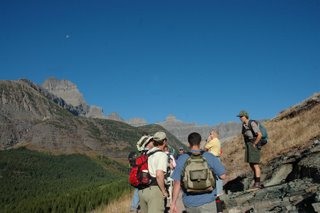
Nearly 20 of us have spent the morning hiking through the firebrush, trembling aspens and hemlocks blanketing the hillsides of sedimentary rock on the east side of Glacier National Park. Our ranger-led walk will take us nearly five miles in from the trail head to Iceberg Lake, a glacial pool tucked against the back wall of mountains we’ve seen the day before from Going to the Sun Road. Total hike: Close to 10 miles.
Boardman and husband Wayne are making a two week trip that includes Yellowstone and Grand Teton national parks. “I just want to get outside, away from the computer and cell phone,’’ she says. 
No one mentions the fact that this is 9/11, the fifth anniversary of the horrific terrorist attack. Perhaps no one really remembers; unless your watch tells the date, it’s easy to forget about the outside world when you’re surrounded by such natural beauty.
We didn’t imagine when we’d left on this hike that we’d be coming all the way to this far rock palisade; it seemed a million miles away. But here it is, sheltered in the far side Iceberg Lake.
Even standing at the pool’s edge, this all seems so small. Yet ranger Ginny West tells us that the cliff face rises 3,000 feet from the top of the lake, itself a half-mile across and 150 feet deep.
Glacier’s no longer cling to the rock, though a few thick snow patches remain. Even those are far smaller than when West first arrived in Glacier, 16 summers ago. As for climate change, West answers “yes, yes’’ – the change is due to natural cycles but is hastened by human activity. 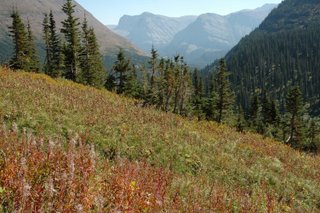
Posted by
DARCOS CRUZ
at
1:45 PM
1 comments
![]()
![]()
Big Red Bus

If you’re Going to the Sun, take the Red Bus.
Going to the Sun Road is the ultra-scenic route through Glacier National Park, Mont., across the Continental Divide. The Red Buses are 1930s era touring cars with a canvas roof that rolls back for ultimate views.
But the Red Bus’s virtues aren’t just the skyward scenery and the pleasure of leaving the driving to someone else. The real reason you want to take the Bus is drivers like Matt Isobell, whose love and knowledge of Glacier National Park make this a journey in time.
Isobell is a former marine who loved the area so much he moved here, to a woodsy cabin without indoor plumbing. Winters, he works on his novels.
“If you want to see animals, go to Yellowstone,’’ he tells us. “This is the park to come to see scenery.
The Red Bus offers a range of tours; we’ve opted for the shortest, a half-day guided ride to Logan Pass and back to the 1913 lodge at Lake MacDonald.
From Isobell we learn that the trees with the drooping tops are hemlocks, that the Spanish moss-like growth in the trees is lichen, and how to tell a black bear from a grizzly (hint: It’s not the color.) This is important because if you run into one in the wild, you need to know whether to fight (black bear) or play dead (grizzly.)
The mountains here are sedimentary rock, created by a billion-plus years of inland seas that ebbed and flowed, depositing silt. Plate tectonics, water and glaciers took care of the rest, creating peaks that sometimes look as smooth as Egyptian pyramids and other look like a swirl of Rocky Road ice cream scooped out by a bear’s claw.
The 26 glaciers in the park today are not remnants from the Ice Age but left overs from a gold cycle about 200 years ago, we learn. Scientists estimate that all the glaciers will disappear here by 2030 – a result of climate change.
We have Ford Motor Co. to thank for the buses, says Isobell. In 1999, Glacier’s 33 Red Buses were starting to fall apart. Ford spent $6.5 million to restore each, adding 5.4 litre V8 engines that run on propane.
The Red Bus tours are so memorable that 38 years after taking his first one, as a college student, Dennis Troseth of Minnesota and the Florida Keys is back for an encore with wife Susan, who came here herself 50 years ago.
“I always wanted to come back. It’s so natural,’’ she said.
Posted by
DARCOS CRUZ
at
1:37 PM
1 comments
![]()
![]()
Paddle, then saddle

Whitewater rafting can be an adventure for the brave. My last whitewater trip involved two dozen Class 5 rapids in the course of a day, followed by a rugged quarter-mile hike out of a canyon. I swore I’d never take another.
Ah, but you voted for me to do a paddle saddle – a full day of rafting and horseback riding arranged by Wild River Adventures in West Glacier, Mont.
OK, here’s the secret: This is fall. And in fall in the northern hemisphere, most rivers are calm. Some are closed for the season.
So I was pretty sure I was in for a fairly tame ride, which suited me fine.
Our guide for the day, Chuck Hunter, took five of us on a leisurely, three-hour float from Moccasin Creek to the Flathead River, just outside Glacier National Park. The hills are covered with spruce, firs and hemlock sprinkled with shimmering Aspens just giving way to the yellows of autumn. It gave us plenty of time to admire the scenery and learn about the river when Big Water is the rule, bringing the levels up 8 to 15 feet above current levels. Now we were drifting at 600 cubic feet of water per second, but in spring the levels rise to 20,000-35,000 cubic feet per second. “It’s a different river every day,’’ he told us.
In between the ripples of whitewater, we admired the scenery and bemoaned the lack of funding for the National Parks. “It’s really important that we let people know what’s happening,’’ said Ruth Bradburn of Chicago. “It’s a major problem.’’
“Look at the color of that water coming over those rocks with the historic bridge in the background,’’ she marveled. “Now, that’s a memory for a cold Chicago winter day.’’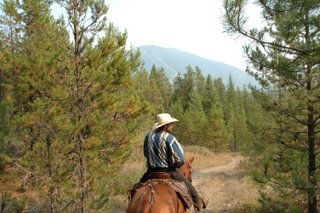
The afternoon “saddle’’ part of the day was proof that cowboy culture isn’t just the stuff of Western novels and vintage movies – at least not in Montana.
Dale Osteen, guide, took me through a forest of 40-foot lodgepole pines, so perfectly pointed they belong on the “grounds’’ of a child’s train set. Wild strawberries and huckleberries grow along the trail, their berries long consumed by forest creatures. But the knick-knicks – small red-berries with leaves once used by native peoples as tobacco – remain, with white winterberries and thimbleberries. The leaves have started reddening, dressing for the fall.
I rode Cheers, a sweet gelding whose young owner had sold him to pay for modeling school in New York.
When you ride, you chat. Dale regaled us with stories of horsemen injured in terrible accidents that would have killed lesser men, a young Australian horseman whose American colleagues were so envious of his abilities that they plotted to get him thrown from the country. A horse so good with austistic children that Dale had cried when the horse had to be put down.
He told us too, of a recent Florida couple who had gone with him on an overnight ride, only to run out of cigarettes. Instead of sitting around the campfire, the trio rode down to a nearby bar. “I think they liked that part of the trip best, the idea that they could ride their horse to a bar.’’
So, what if you have one too many? Not good, he told us; riding a horse while impaired qualifies at drunk driving. Happened to him once, years ago, in Bakersfield, Calif. Seems the judge didn’t think the horse qualified as a designated driver.
Posted by
DARCOS CRUZ
at
1:32 PM
0
comments
![]()
![]()
Solo no more

In the spirit of full disclosure, I need to say that the solo portion of this trip has ended. The Husband met me as I arrived at Glacier National Park and will stick with me for the next few days.
I let him drive in the park, but I’m driving the rest of the way to Seattle. Aside from the issues of vehicular control, there’s pride: You can’t say you drove cross-country if you didn’t do the driving.
Posted by
DARCOS CRUZ
at
1:21 PM
1 comments
![]()
![]()
Monday, September 11, 2006
A thumbs up sign, but no (wireless) signal
Deep in the foliage of Glacier National Park, Jane is yet again without internet access (and phone access in most areas as well).
She will be within range by tomorrow evening to post about her latest adventures.
--Stephanie
Posted by
Anonymous
at
6:12 PM
2
comments
![]()
![]()
Sunday, September 10, 2006
Early days of the trip
If you missed the early days of this trip, check out the archives.
Just to go the column on the right and scroll down until you get to them. This trip began in August, so the first 10 days are posted under archives for that month.
Or just click here.
Posted by
DARCOS CRUZ
at
6:13 AM
2
comments
![]()
![]()
Into Glacier
Today I head into Glacier National Park. I'm starting with a ride on the Road to the Sun via an historic red touring car, so I can look and learn without driving myself.
Tonight I'll stay inside the park, and I may not have Internet access. If that's the case, I'll be back in touch the next day, as soon as I get access again.
Have a great day.
Posted by
DARCOS CRUZ
at
6:04 AM
0
comments
![]()
![]()
Your questions
Debbie, a reader who has offered many great comments along the way, asked the other day about road food. I’ve thought about her question and done some additional research.
Barbecue from Birmingham to Montana has been varied, tasty and plentiful. But even a barbecue aficionado can eat only so much of the stuff, and you have to try something else.
That’s when the trouble starts. The sad news is that chains have taken over America’s road ways. Occasionally you do see promises of “home cooking.’’ This apparently is a euphemism for “lots of starch.’’
Jane and Michael Stern have written a guide, Roadfood, that identifies great home cooking across America. Their guide doesn’t mention restaurants along the path I’ve traveled in the past 10 days or so.
Good regional food is available, but it usually lies far from the main roadways. In Hot Springs, S.D., I ate at Scotty’s, which has a great Sunday buffet with salad bar, slow-roasted meats and yummy casseroles.
In Butte, Mont., I ventured into the Historic Uptown District. I bypassed the buffalo sausage and burger joint for the Uptown Café. This turned out to be a friendly place where most everyone knew each other and the ladies who run it went out of their way to be helpful. By night this is a gourmet dining experience, but at lunch it’s more casual, with a salad bar, soup and a couple of entrees served cafeteria-style. The clam chowder was terrific, both light and flavorful – despite the distance from the sea.
---
Several people have asked about my daily routine on this trip. It generally goes like this:
Up at 6-6:30. Load blog materials online and grab breakfast from the motel cereal bar; in the car and on the road by 8 a.m. Spend day driving, fulfilling your assignment to me and checking out other points of interest. Find a motel room by 7. Take an hour or so for dinner. Write blog entries; load video and images so Stephanie can access them. Use the Internet to plot the next day’s trip and identify potential lodgings (though I don’t always use them.) Hit the hay.
A quick pace, but never dull.
Posted by
DARCOS CRUZ
at
5:47 AM
2
comments
![]()
![]()
Friday, September 08, 2006
One long day

Today wasn't the longest in terms of miles -- I drove about 350 today -- but between road construction, traffic and the wildfires smoldering in Idaho, southern Montana and north of Missoula, it was one tough drive. The scenery coming up 93 around Flathead Lake is probably spectacular, just veiled in smoke.
Now I'm here in Whitefish, Mont., at the cabin of friends who read about this trip and graciously offered it up. Thanks! (By the way, your neighbors have a wireless connection!)
Posted by
DARCOS CRUZ
at
6:12 PM
2
comments
![]()
![]()
New videos
Super Stephanie, my partner here on the blog, has posted a new batch of videos I've taken along the way. You can find them by clicking on the Where's Jane? logo at the top right. Once you get to the page with the map, click on "Photos and Videos'' in the lower right corner.
If you had trouble viewing them before, try it again. We've changed the technology set-up, and this is easier.
Also, our latest video for Travel on Demand, a joint project between The Miami Herald and Comcast, is online. The video gives tips for fall leaf-peeping. Check it out by clicking here.
Posted by
DARCOS CRUZ
at
8:02 AM
0
comments
![]()
![]()
Home on the range
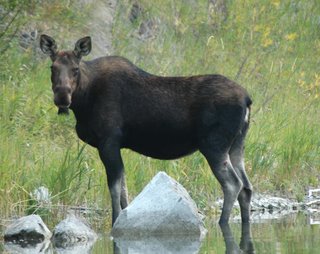
Driving through the West, you often see signs for guest ranches. Some are simple collections of cabins with trail rides as an amenity. Others are far more.
One of these is Papoose Creek Lodge, about 40 minutes west of Yellowstone National Park, and set on the edge of national forest land. 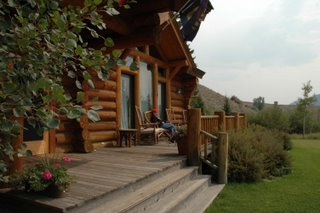
Papoose Creek is combination upscale boutique hotel, wilderness retreat, dude ranch, eco-tourism operation and fly-fishing camp. It promises luxury, wilderness style, and it delivers with knowledgeable, affable staff; comfy beds and duvets; and gourmet meals. There’s a hot tub and massage but no full spa. Turn-down service but no butler. In other words, it provides comfort but not cosseting.
And you wouldn’t want it. People come here for four days to a week to enjoy the outdoors and get away. There are no phones or TVs in rooms (though the office has phone and Internet); Blackberries and cell phones don’t work here.
“I took off my watch when I got here. This has been the most relaxing vacation,’’ said Susan Gray of Atlanta. She and husband Ken came to celebrate their 30th anniversary.
It’s also like a giant house party. Guests eat as a group, choosing from a vast breakfast selection (eggs benedict, home-made oatmeal, fruit); menus like grass-fed beef burger, sandwiches and roasted vegetable pizza for lunch; and a four-course dinner with choice of entrée. All meals are cooked to order.
Staffers are mostly twenty-somethings who love fishing or horses or are just taking a breather before the next career move. One is Madeleine Alkire, who turns out to be the college roommate of Miamian Penny McCrea, of the Miami Herald’s ActionLine. Small world.
Daily activities include an afternoon happy hour, which might be how the whole music party got started the first night I arrived.
We had opted to dine on the deck overlooking a stream. Topics turned to the sorts of universal themes that easily bind strangers, like your favorite episode of Seinfeld. At some point – about the time the staff retired – Ken got his Ipod and speaker set. He’d claimed to have eclectic taste, and quickly proved it, with selections from the Dixie Chicks to Safety Dance to gangsta rap. Never could find Iron Butterfly’s In-A-Gadda-Da-Vida, though he swore it was on there somewhere. 
Of course, people really come here to commune with the great outdoors. Each day guests choose from horse riding, canoeing, fly-fishing, hiking, cooking lessons, trips to Yellowstone. There are plenty of opportunities to learn about the ranch. Once owned by actor Steven Segal, Papoose Creek and the 25,000-acre sister ranch next door lie in the Madison River Valley, sitting about 5,000 feet at the valley floor and rising to 11,000 feet in the surrounding mountains. It now provides summer grazing for about 1,600 steers and is involved with conservation efforts for elk and trout, and wolf interaction research.
One of Papoose Creek’s biggest draws is the Madison River, a catch-a-release river run wild since it was originally stocked with brown trout in the late 1800s, and now boasting about 4,200 trout per mile.
I didn’t fish; my fishing karma is crummy. You voted for me to go canoeing and horseback riding, and both I did.
The canoe trip took Jill and Allen Johnson of Las Vegas and me to Cliff Lake in the national forest. Our guide, Curtis Brown, brought along his sweet dog, Maddy, and during our three-hour canoe trip we saw only two other boats. The setting – azure lake rimmed in firs – would have been magic enough, but we got lucky with wildlife and spotted two bald eagles, oprey and hawks. And we had the rare treat of a young moose cow grazing near the water’s edge who let us get with 20 feet of her. A great morning.
The afternoon took the same three of us riding high into the surrounding mountains with wrangler Ryan Bell, a history and Italian language major who has decided to immerse himself in cowboy cultures around the world. His last stop was a three-year stint in Patagonia. In a few years, he’d like to head for either Mongolia or Australia. Not a bad life on the ranges.
Posted by
DARCOS CRUZ
at
7:36 AM
7
comments
![]()
![]()
Thursday, September 07, 2006
Old Faithful
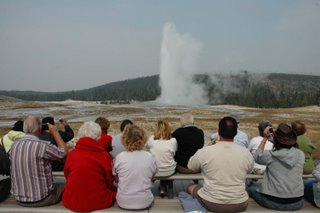
If there is hell on earth, it might be Yellowstone National Park.
Geysers, boiling mud caldrons and sapphire hot springs dot a silica-bleached landscape that appears to be burning. In truth the burn lies beneath, in a sizzling pool of magma just three miles below the surface. The acne-scarred earth above is eerie and haunting, and undeniably beautiful.
Yellowstone is home to 400 of the world’s 600 geysers. The most famous is Old Faithful, famous largely because of its predictability, but also because it is easily accessible, say park rangers. “A lot of people are in a hurry, and they can come see it and then move on,’’ said ranger Jeanne Kearney.
Every 92 minutes, give or take, Old Faithful spews forth it’s frustrations in a 2 ½ minute stream of steamy invective, typically reaching heights of 130 feet.
Visitors gather 15 minutes in advance, numbering as many as 3,000 to 4,000 in peak summer months. Even on this hazy day when the sky is veiled by smoke from Montana wildfires to the north, there’s a sizeable crowd.
Old Faithful gives a few false starts – a sign that the pressurized water beneath the earth is about to push past the four-inch constriction through which the steam passes. Then “Oh!’’ cries the crowd as the geysers sprays high and hard. The water that hits bystanders has already cooled by the time it falls to earth.
Except for its regularity, Old Faithful is one of the least impressive geysers in the nation's oldest park. Some others blow harder and longer, like Castle, which blasts about every 13 hours for around 52 minutes.
The geysers are only olne of Yellowstone’s attractions. Buffalo, deer, moose and elk roam here. The views are wide and long, over lakes and ridges and through endless valleys cut by crystalline streams. At the park’s north end sits Mammoth Springs and it’s extraordinary travertine terraces created by years of mineral deposits from the thermal features.
Yellowstone is actually the caldera of a vast volcano that blew 640 million years ago, then collapsed, with its molten lava just beneath the surface. Some day soon it will likely blow again – though "soon" in geological terms can be a few million years or so. No need to worry.
Posted by
DARCOS CRUZ
at
8:23 AM
1 comments
![]()
![]()
Wednesday, September 06, 2006
Freedom of speech
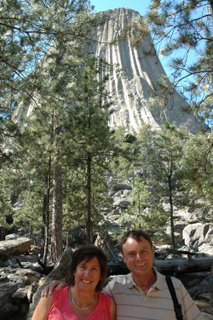
Many days have offered great sightseeing. But fewer have offered great people experiences.
In the South, even strangers say hello to you on the street. And if you’re in a defined situation – say, you’re a guest in a hotel – the staff seems generally friendly.
But even at national parks and local eateries, both locals and fellow travelers often seemed self-contained and wary. On this trip, those most likely to chat have been other urbanites, like the Jacobs family (Josh; Lisa; Jennifer, 8; and Zachary, 13), whom I met in Custer State Park. Perhaps they sense a kindred soul.
Today was great in every regard: Great scenery; a cool, crisp pre-fall day – and terrific people.
Rudy Satchet and Barb Kliner were watering Collins, their sheepdog, when we first said hello, as we were taking photos of Devils Tower at an overlook. We both stopped again at another overlook and found ourselves laughing about the antics of the prairie dogs near by Devils Tower entrance.
Satchet and Kliner live and work in East Palestine, Ohio. They’d decided on a two-week roadtrip, making plans each night as they go via the Internet (a familiar process.)
His goal: To stop in towns with 300 people or less – to keep away from other tourists. She was beguiled by attractions along the way. “You see the little signs about the road, and I think, ‘I want to go there!’ ‘’ Both the Spam Museum in Austin, Minn., and the Corn Palace in Mitchell, S.D., had rated highly.
Charles and Eunice Parker of Liverpool, England, are part of a 16-day motorcoach tour of Western U.S. national parks. We met at Devils Tower.
“You need a lot of film, don’t you?’’ Charles said as we walked the 1.3 mile path around the tower’s base. They were only a couple of days into their trip, but they’d also ready visited both Mount Rushmore and Crazy Horse Memorial. “Crazy Horse was very emotional. It just blew me away.’’
It was in the bar of the historic Irma hotel (think bighorn sheep heads on the walls), in Cody, Wyo., that I met a trio of 20-somethings: Scott Richard, Andy Steinberg and Southgate Freeman, who goes by Sox. I overheard them talking about Scott’s new Internet business (free local classifieds) and Sox’s dream of writing a movie.
Andy and Sox are roommates, Scott and Sox are cousins, and Scott is married to the gorgeous Misty, who works the bar at the Irma. We talked about the topics that generally come up in bars when there’s no sporting event on TV: their girlfriends, politics, religion and land values.
Land values: Still pretty decent in Cody, but heading up.
Girlfriends: These guys are nice, and had nice things to say about their girlfriends – or in Scott’s case, his wife. Andy spent most of his time talking with her on his cell; Sox messaged his on his phone.
Politics: Well, let’s just say that we didn’t agree on much, but we enjoyed the friendly disagreement, and nobody left mad.
Religion: Surprisingly enough, we did agree there.
Just the ability to talk about it all without anyone getting irritable was a pleasure. A distinctly American pleasure.
--------
Photo: Charles and Eunice Parker of Liverpool, England
Posted by
DARCOS CRUZ
at
6:39 AM
3
comments
![]()
![]()
Devils Tower
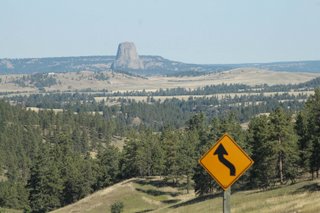
To 19th Century artist and explorer Thomas Moran, Devil’s Tower was “a grand and imposing sight, and one of the most remarkable physical features of the country.’’ To Native Americans, this 600-foot natural obelisk was a sacred site, “vital to the health of our nation and tow our self-determination as a Tribe,’’ according to Romanus Bear Stops, a Cheyenne River Sioux. To the makers of Close Encounters of a Third Kind, Devil’s Tower was a natural for an alien landing pad.
It is surely otherworldly, a strange and almost mystical apparition on a long horizon. For me, what was most remarkable was the vertical stippling – sometimes a dozen feet wide – that rises more than 1,200 feet above the Belle Fourche River, first on a hillock and then on granite boulders, and finally in sheer rock.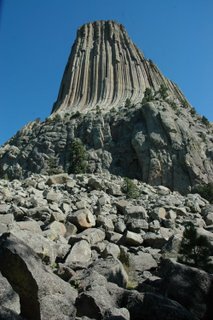
It was the river that carved this granite monolithe, wearing about the softer sand and limestone of seabed deposits over the past 50 million years.
In 1906, President Theodore Roosevelt named this the first U.S. National Monument. The sheer verticality of it, and its height, make it indescribable.
And apparently irresistible to climbers. Several groups were freelclimbing up its walls today – an image so astounding that visitors kept stopping and ogling, and wondering how anyone gets the nerve to play Spiderman without supernatural powers.
Another man was led by his wife, who read the markers along the way, and it seemed that he was blind. A reminder that there’s more than one way to see things, and that many of us have superpowers.
Posted by
DARCOS CRUZ
at
6:35 AM
0
comments
![]()
![]()
Tuesday, September 05, 2006
No dead wood here

It’s a little disconcerting to walk into a Comfort Inn and find a casino, but then again, this is Deadwood.
After the government closed up the brothels, Deadwood, S.D., was, almost literally, dead. In the late 1980s, the town talked with government into allowing gambling … the first place outside Las Vegas and Atlantic City to do so. It made some sense: Deadwood had been a gambling center back in the Wild West days of the late 1800s. The proceeds – about $180 million so far, said local Tom Griffith – go to historic preservation, both of homes and the now-thriving downtown, and about 1 million tourist come here each year.
I got in just before sunset. Tom, a local businessman and travel writer, and wife Nyla, who sits on the town commission, took me to dinner with a couple of other locals, Pat and Jean. It was a fun night, proof that despite South Dakota’s conservative reputation, there’s no shortage of opinion on all sides of the key issues. (As someone pointed out, this is the state that gave us George McGovern.)
This is the same Deadwood as in the HBO series, and just in case you’ve missed the point, there are daily reenactments of the murder of Wild Bill Hickock in the Old Style Saloon No. 10. The saloon was once down the street, but that was before the town’s megafire a century-plus ago, and today’s bar may not be an exact replica, but the spirit is authentic.
The place is covered with animals heads and historic photos, including ones of Wild Bill – he’s buried up on the hill at Mt. Moriah Cemetery – and Calamity Jane, who is buried next to him.
The Wild Bill story goes like this: Jack McCall got off murder charges by telling the judge that Bill had killed his brother. Then the courts found out McCall had no brother, so the law tracked him down and hung him.
No. 10 Saloon isn’t the town’s only high-profile establishment. After Kevin Costner filmed Dances with Wolves in the area, he opened The Midnight Star. The three-story operation is classic Deadwood: gambling, dining, bar, plus movie memorabilia to boot…well, to the killer boots Whitney Houston wore in The Bodyguard. Too bad they’re not my size.
Posted by
DARCOS CRUZ
at
6:53 AM
0
comments
![]()
![]()
Family dream

A few miles down the road from Mount Rushmore sits the Crazy Horse Memorial. Unfinished, it stands as witness to a story even more dramatic than that of the presidential mount.
Award-winning sculptor Korczak Ziolkowski, son of Polish parents, was invited by the Lakota Indians of the Black Hills to create a monument to native Americans. He accepted, and began work in 1949. He had no funding, few tools, no help.
But from the beginning visitors stopped in to watch the work, recalls wife Ruth, who carries on the project today with 7 of the couple’s 10 children. Some 5,000 came that first year.
In the early years, Ziolkowski worked entirely alone; he died in 1982. Today a crew of seven engineers, blasters and sculptors continue the slow process year after year.
The project is a non-profit organization and takes no government funding. Korczak Ziolkowski believed in the strength of the individual, and the government’s track record with funding and with native Americans isn’t admirable. Most of the money comes from visitor entry fees; about 1.5 million come each year.
The monument is designed to honor all native Americans, but to date, only one tribe has made a monetary contribution. “They’re just finding out about us,’’ says Ruth, now 80. As we chat, people keep coming up to her, thanking her for the work here, and she’s clearly considered a local treasure.
There’s no time table for finishing the project, but in 7 to 10 years the plan is to have carved away all the surface rock to within 20 feet of finishing. This is no easy task; more than double the amount of rock carved from Rushmore has already been blasted off the rock face. And this sculpture is massive: Rushmore’s four presidential faces would fit on the side of Crazy Horse’s head. The sculpture stands 563 feet tall and 641 long, and it’s a sculpture in the round…not just against the mountain face.
It has become a family dream, if not obsession, and witness to what one can do with little more than tenacity. Today the visitor center includes a large museum, Native American crafts center, gift shop and eatery. Once the monument itself is finished, the family plans to create a bigger museum and university and medical training center for Native Americans.
Says Ruth: “You’ve got to have faith.’’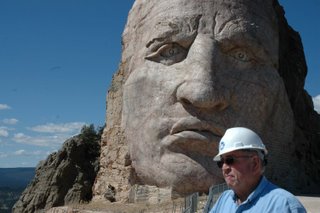
----------
Photos: Top, the sculptor's model, 1/34 the size of the real thing, with the mountain in the background. Above, tour guide Don Gifford stands atop the arm, the finished face behind.
Posted by
DARCOS CRUZ
at
6:44 AM
0
comments
![]()
![]()
Presidential monument
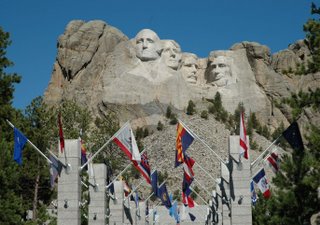
Mount Rushmore is an American icon: a testament to big ideas and perseverance. For South Floridians, it’s also probably the best-known feature of South Dakota’s Black Hills, and it’s where you sent me on Labor Day.
I wasn’t alone. The national monument gets about 3 million visitors per year, and plenty of them had turned up on this holiday.
Among them were a group of schoolmates meeting up for a weekend, along with wives and girlfriends: Greg Woods and Amelia Elomier of Denver, Jody and Matt Michael and Clay and Holly Schulte of Walker, Iowa. Some had been when they were kids, or even just a few years ago; for others it was a first-time visit.
“Until you’re here, it doesn’t sink in,’’ said Matt Michael. “There’s a lot more to do than just look at the mountain.’’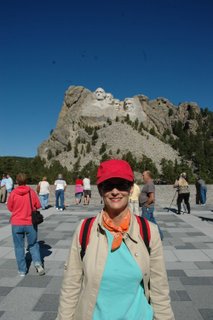
The very scale of the carvings is amazing. The faces stand 62 feet tall on a granite mountain, and on a ranger tour I learned that Jefferson had been completed and was later erased and moved to his current position.
The idea of the monument came from a local historian in 1924, who had heard of mountain carvings in Stone Mountain, Ga., and thought a tribute to Western heros this would be a good way to get visitors to the Black Hills. Sculptor Gutzon Borglum transformed the idea into a tribute to four American presidents of his own choosing: Washington, for leading the birth of the country; Lincoln, for preservation of the union; Jefferson, for his expansion of the country through the Louisiana Purchase; and Roosevelt, for his love of the outdoors and the rights of the common man.
A few juicy stats: Building the monument took 14 years. Each day the workmen climbed 760 steps with 65-pound jackhammers; at the top they were then lowered on cables. Pay ranged from 45 cents per hour to $1.25 per hour – which was pretty good during the Depression. Over 450,000 tons of rock were removed during the carving, which was never quite finished due to World War II. Not a single person was killed in the effort. 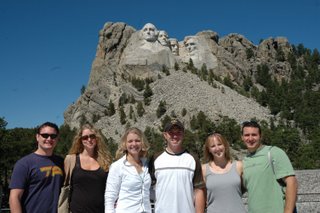
----------
Photos: Top, Mount Rushmore's Avenue of Flags; center, Jane at Mount Rushmore. Above, schoolmates (from left) Greg Woods, Amelia Elomier, Jody Michael, Matt Michael, Holly Schulte, Clay Schulte.
Posted by
DARCOS CRUZ
at
6:35 AM
0
comments
![]()
![]()
Monday, September 04, 2006
Cool
The local Black Hills newspaper, The Rapid City Journal, wrote a story about our trip! It appeared in the local section of today's edition. The Journal is currently redesigning it's website, and it's local stories aren't posted at this point, so we can't share. Reporter Scott Ost wrote the story.
Posted by
DARCOS CRUZ
at
10:12 PM
0
comments
![]()
![]()
Road hazards
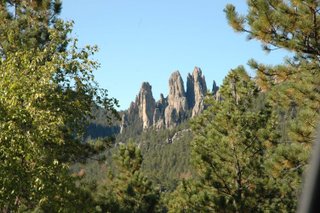
If the eye-catching scenery of South Dakota’s Custer State Park doesn’t distract you, the road hazards will. 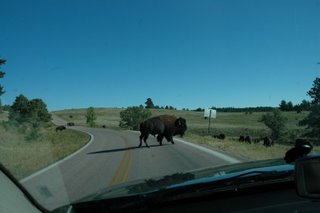


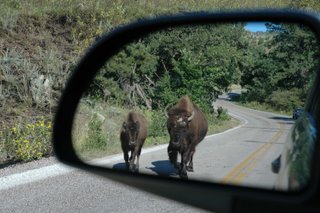
Posted by
DARCOS CRUZ
at
10:00 PM
0
comments
![]()
![]()
American safari
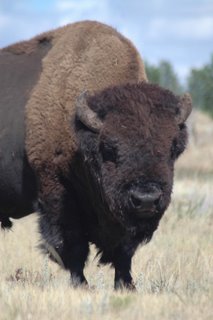
The Jeep Wagonneer bounces over the dirt road, wind rushing through its open windows. The hunt is on.
This isn’t a hunt with gun or bow and arrow, though a certain number of those permits are offered by lottery each year. This is a wildlife safari, as enticing as its African counterpart. But we aren’t after elephants or lions or even the mammoths that once ranged these prairies. We’re after bison.
A herd ambles past, grazing and moving, moving, moving on a nightly migration. Leading is a dominant female, says guide Bud Pearthree; bison society of matriarchal.
Call them buffalos or bison, the huge-shouldered beast is the same. About 1,500 live here in the 71,000 acres of Custer State Park, S.D., the second largest state park in the nation. About 500 will be culled from the herd this fall; 1,000 will winter over. The others will be sold for breeding.
“I love the outdoors, and I love animals. I don’t classify this as work,’’ Pearthree says. For the past decade, he has come here from his winter home of Minnesota to tell some of the park’s 1.8 million annual visitors just about everything you could want to know about bison and other wildlife here in the park. 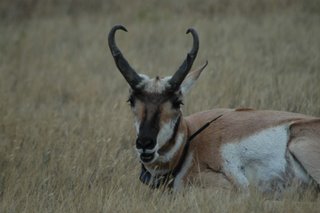
Ahead is a male pronghorn – an antelope-like animal – marking territory by digging and thing urinating and defecating on the ground, in preparation for the mating season. Pronghorn can run up to 60 miles per hour, Threepeach says; only a cheetah can catch them, and those don’t live in this part of the universe.
We spot mule deer, wild turkeys, quail, even a prairie dog. On the hard-top road, mules stick their heads in our Jeep, begging for food. We bounce into the back country in search of elk, with no luck.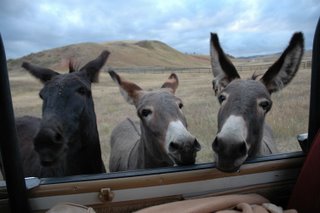
But it’s the bison that again and again catch the attention. A bull can weigh a ton; a big cow can be 1,000 pounds. And while they don’t bother with our Jeep, bisons can be dangerous if you get out of your car or approach them. Several people have been gored over the years, and one even killed.
Once, 350,000-400,000 buffalo are said to have roamed North America, but by the late 1800s, the numbers were down to about 800. In 1913 the land that would become the park was established as a game reservation; buffalo were introduced in 1915, and the area became a public park in 1919. The Custer State Park herd is said to be the country’s largest.
And while you can often spot several from the road, a Jeep tour onto the back roads ups the chances of getting an up-close view. Of course, you can’t get out of the Jeep … your visit might get a little too personal.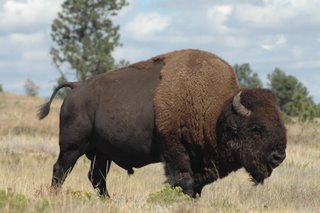
A big bison event: Oct. 2 is this year’s date for the annual Custer State Park roundup, when the bison are herded into corrals for branding and tagging. More than 6,000 typically attend.
Posted by
DARCOS CRUZ
at
9:52 PM
1 comments
![]()
![]()
